Retaining Wall and Road
Heritage object
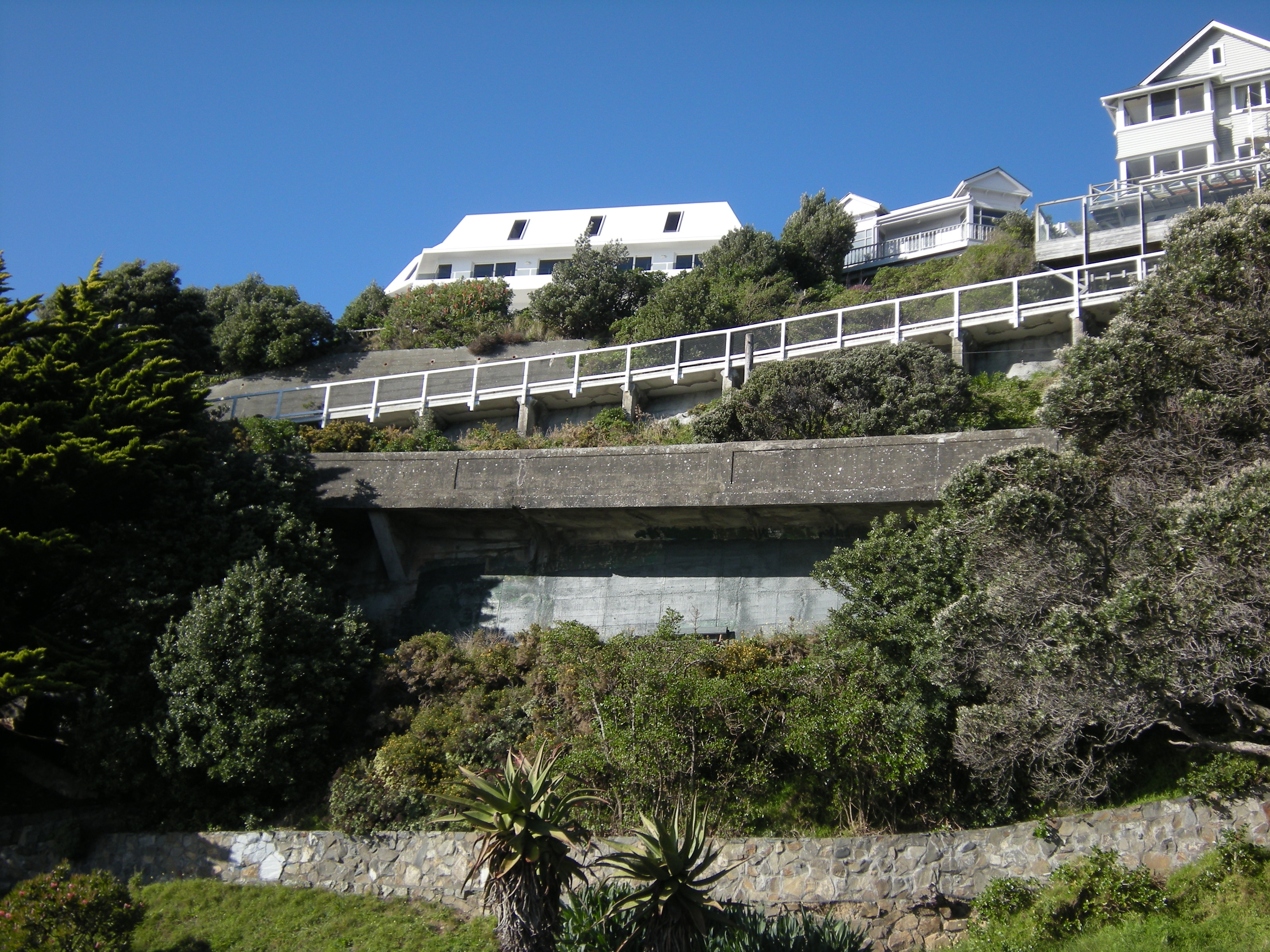






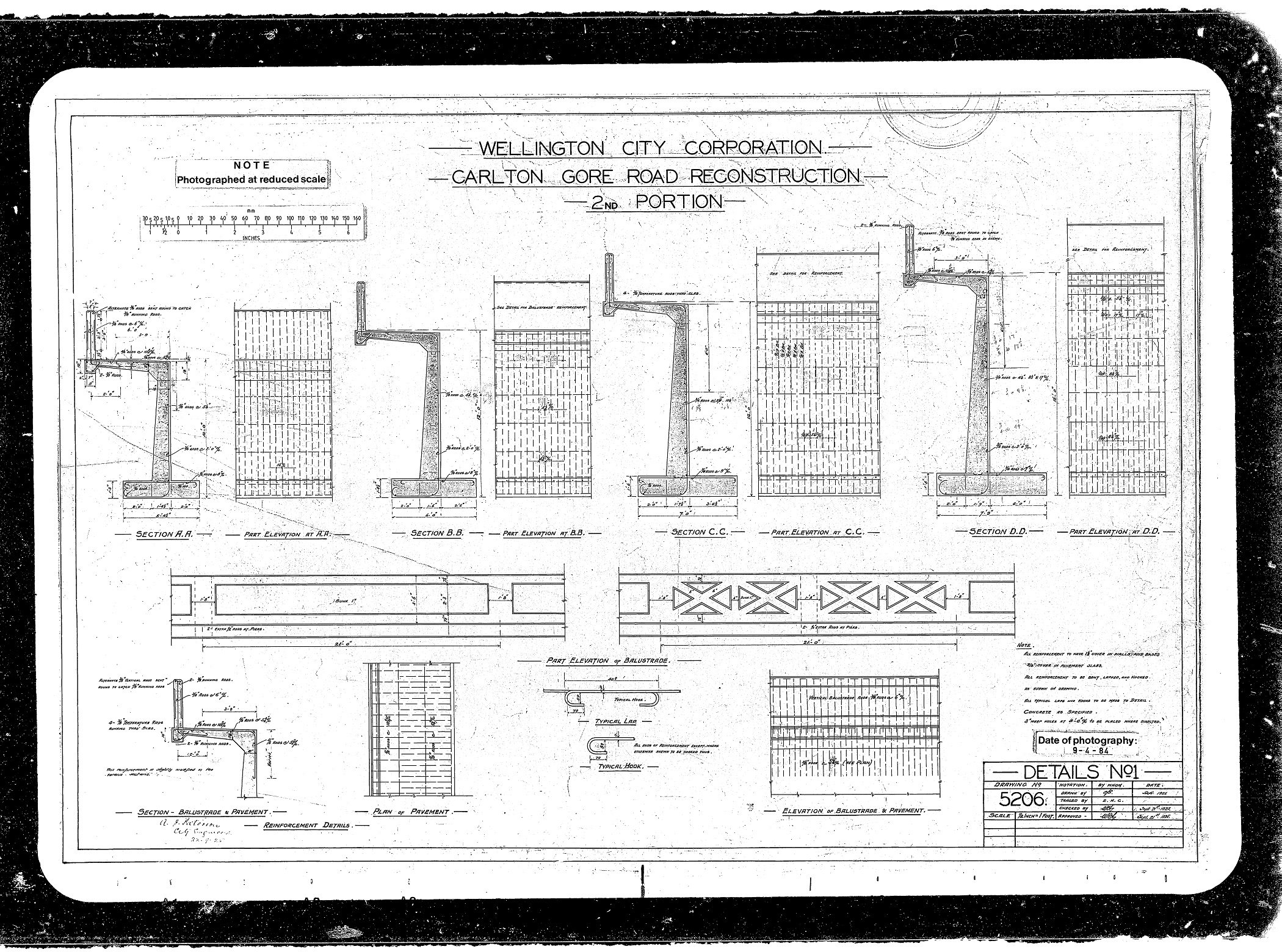
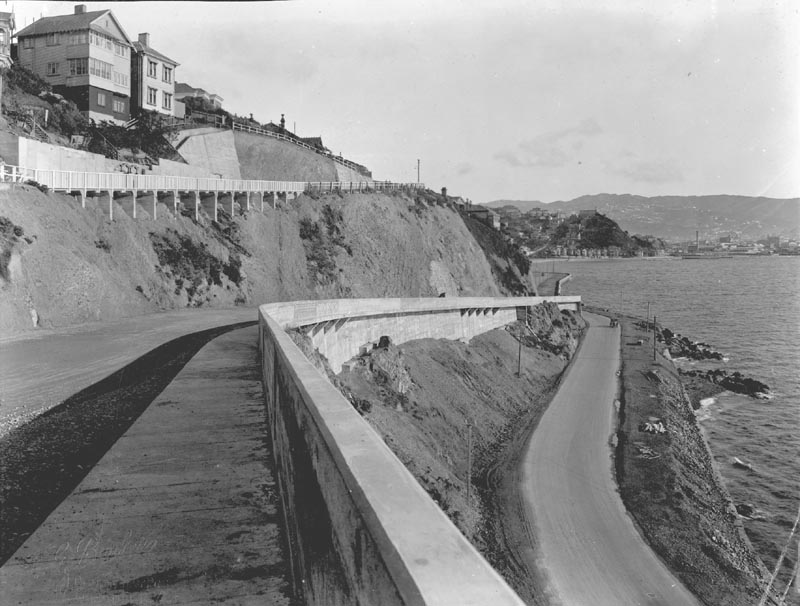
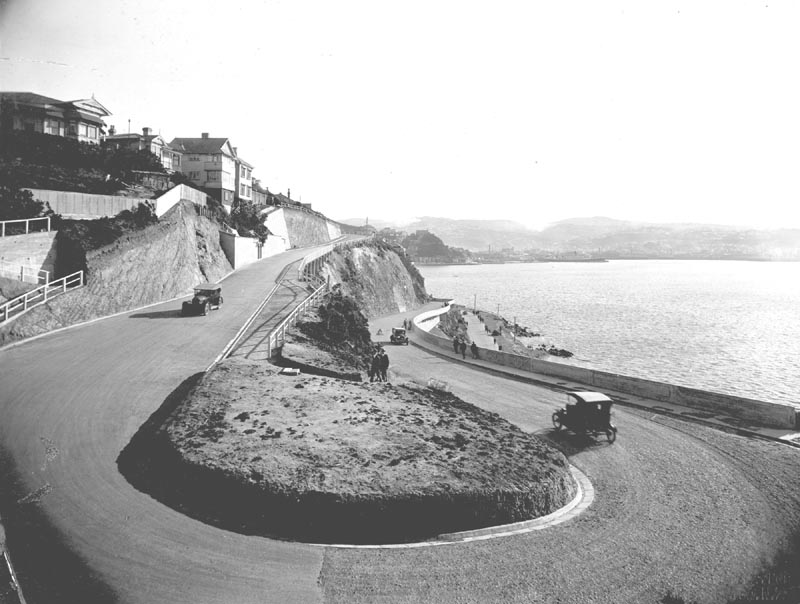
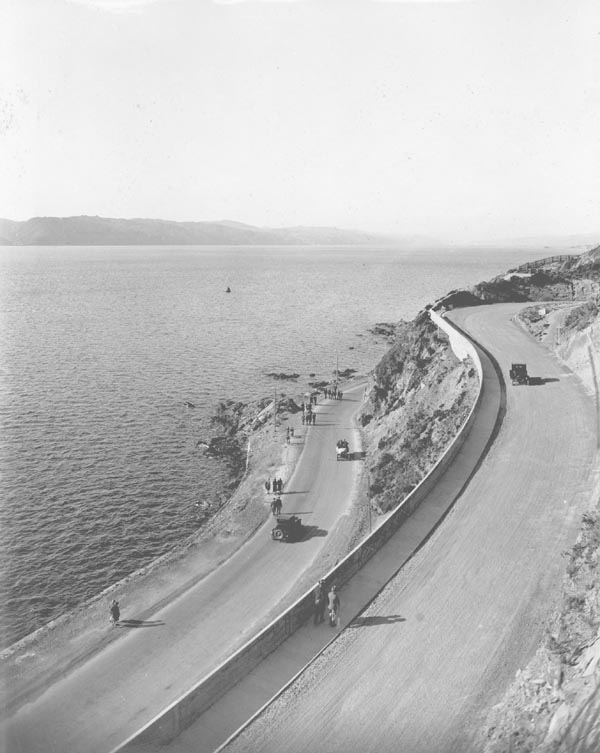
-
Constructed
1925 - 1930
-
-
Architect(s)
-
Builder(s)
Fletcher Construction Company
-
The Carlton Gore Road and Retaining Wall is an important early civil engineering structure in the Wellington region designed to improve access between Oriental Bay and Roseneath.
The Carlton Gore Road and retaining wall is associated with urban expansion and the requirements for new amenities that expansion created. The road was meant to address the need for better access between Roseneath and Oriental Parade and contributes significantly to the historic character of these areas. It is associated with the development of the city, early engineering works, and the development of Wellington suburbs.
There is technical value in the construction of the road and retaining wall, as several different solutions have been used to deal with the challenging topography, and in the use of reinforced concrete.
-
Downloadable(s)
-
close
History
-
The Carlton Gore retaining wall and road, which connects Oriental Parade with Roseneath, was constructed between 1925 and 1930 during a series of infrastructure improvements instigated by two Mayors, Mr C.B. Norwood, and Mr G.A. Troup.
There had previously been a simple road linking Oriental Parade with Roseneath, but its quality and conditions had been a cause for concern and complaint for a number of years, in particular from residents.
A number of options had been proposed to give better access to Roseneath, including the construction of a lift or inclined tramway. By 1925 it had been decided that road improvement was the most appropriate means of upgrading the access to the suburb.
Considerable preliminary work was carried out to prepare the new Carlton Gore Road. By late 1925, the first length of the retaining wall (from the junction of Carlton Gore Road and the Bay Parade) had been completed by the Wellington City Corporation. The next lengths (to the hairpin bend) were to be two distinct types of construction and had been contracted to Fletcher Construction Company.
The first length of the retaining wall was constructed in reinforced concrete, the wall being on the outer edge of the twenty four foot roadway and a six foot footway. The next lengths were to be constructed in the main, either with piers supporting the footway above the cliff face and no actual wall supporting the road way, or with supporting walls and the footway carried out beyond the vertical line of the wall upon a cantilevered platform. The different options were created so that, depending upon the foundations and the steepness of the cliff, one or the other could be adopted based on its suitability. It appears that no one option was chosen, and a combination of the different options was used for the road building depending upon the topography. Where the hillside was not too steep walls have been used, where the ground drops away more (and where it would be uneconomic to build an extremely tall wall) piers were used, and in cases where neither piers nor walls were an option the road and walkway was cantilevered out.
The balustrade of the lower length is constructed in concrete with a cross design and gives protection from the risk of falling down the bank, as well as serving as a wind break. It was also noted that it was an attractive ‘Maltese Cross’ design. At the upper level (going back towards the city) the footway runs along the outer side of the road on piers. Since the footway is on the outside in both cases, pedestrians have to cross the roadway. It was decided at the time that if the road was to remain economical this would have to do, and it was considered that pedestrian traffic was not marked upon the roadway itself, with most people choosing to take the shortcut up the zigzag stairs near the kiosk (now demolished).
The original paving of Carlton Gore Road was part of experimentation by Wellington City Engineers and the Works Committee of the City Council. In 1925 the council had introduced to ratepayers a paving loan, and a number of hill streets were tested for brick pavement upon a concrete base, as it was considered that a bituminous surface on steep grades would mean trouble for horse drawn carriages. Following experimentation on Carlton Gore Road, the engineers were satisfied that a specially graded mix provides for a surface that is anything but slippery on a reasonable grade.
In 1937 the Wellington Beautifying Society planted 50 small pohutukawa and a number of taupata in an attempt to clothe the clay face of Carlton Gore Road , a number of both of these species remain in place in 2013.
Since its construction the road and retaining wall have had few modifications and remain in relatively authentic condition. Some work was carried out on part of the wall in 2006.
The retaining wall and road is an impressive example of early civil engineering works in Wellington. It is a relatively simple and utilitarian structure built in reinforced concrete that was designed to address the need for better access to Roseneath. It is an important historic object for Wellington and contributes significantly to the streetscape along Oriental Parade. It contributes visual amenity to the area and has played an important role in the establishment of Roseneath as an attractive and popular suburb.
-
Modifications
close
-
1925 - 1930
-
Construction
-
-
Occupation History
close
Not assessed
-
The Carlton Gore retaining wall and road, which connects Oriental Parade with Roseneath, was constructed between 1925 and 1930 during a series of infrastructure improvements instigated by two Mayors, Mr C.B. Norwood, and Mr G.A. Troup.
-
close
Architectural Information
-
Building Classification(s)
close
Not assessed
-
Architecture
close
The retaining wall and road is an impressive example of early civil engineering works in Wellington. It is a relatively simple and utilitarian structure built in reinforced concrete that was designed to address the need for better access to Roseneath. The first length of the retaining wall was constructed in reinforced concrete, the wall being on the outer edge of the twenty four foot roadway and a six foot footway. The next lengths were to be constructed in the main, either with piers supporting the footway above the cliff face and no actual wall supporting the road way, or with supporting walls and the footway carried out beyond the vertical line of the wall upon a cantilevered platform. The different options were created so that, depending upon the foundations and the steepness of the cliff, one or the other could be adopted based on its suitability. It appears that no one option was chosen, and a combination of the different options was used for the road building depending upon the topography. Where the hillside was not too steep walls have been used, where the ground drops away more (and where it would be uneconomic to build an extremely tall wall) piers were used, and in cases where neither piers nor walls were an option the road and walkway was cantilevered out.
The balustrade of the lower length is constructed in concrete with a cross design and gives protection from the risk of falling down the bank, as well as serving as a wind break. It was also noted at the time that it was an attractive ‘Maltese Cross’ design. At the upper level (going back towards the city) the footway runs along the outer side of the road on piers.
The original paving of Carlton Gore Road was part of experimentation by Wellington City Engineers and the Works Committee of the City Council. Following experimentation on Carlton Gore Road, the engineers were satisfied that a specially graded mix provides for a surface that is anything but slippery on a reasonable grade.
-
Materials
close
Reinforced concrete
-
Setting
close
The Carlton Gore Road and retaining wall is a prominent landmark along Oriental Parade. It is an important access road between Oriental Bay and the suburbs of Roseneath and Hataitai.
-
Building Classification(s)
close
-
close
Cultural Value
The Carlton Gore Road and Retaining Wall is an important early civil engineering structure in the Wellington region designed to improve access between Oriental Bay and Roseneath.
The Carlton Gore Road and retaining wall is associated with urban expansion and the requirements for new amenities that expansion created. The road was meant to address the need for better access between Roseneath and Oriental Parade and contributes significantly to the historic character of these areas. It is associated with the development of the city, early engineering works, and the development of Wellington suburbs.
There is technical value in the construction of the road and retaining wall, as several different solutions have been used to deal with the challenging topography, and in the use of reinforced concrete.
-
Aesthetic Value
close
-
Architectural
Does the item have architectural or artistic value for characteristics that may include its design, style, era, form, scale, materials, colour, texture, patina of age, quality of space, craftsmanship, smells, and sounds?
The Carlton Gore Road and Retaining Wall is an important early civil engineering structure in the Wellington region designed to improve access between Oriental Bay and Roseneath.
-
Townscape
Does the item have townscape value for the part it plays in defining a space or street; providing visual interest; its role as a landmark; or the contribution it makes to the character and sense of place of Wellington?
It is an important historic object for Wellington and contributes significantly to the streetscape along Oriental Parade. It contributes visual amenity to the area and has played an important role in the establishment of Roseneath as an attractive and popular suburb.
-
-
Historic Value
close
-
Association
Is the item associated with an important historic event, theme, pattern, phase, or activity?
The Carlton Gore Road and retaining wall is associated with urban expansion and the requirements for new amenities that expansion created. The road was meant to address the need for better access between Roseneath and Oriental Parade and contributes significantly to the historic character of these areas. It is associated with the development of the city, early engineering works, and the development of Wellington suburbs.
-
Association
Is the item associated with an important person, group, or organisation?
The Carlton Gore Road and retaining wall is associated primarily with the Wellington City Corporation, the city engineers who worked on it and the series of infrastructure improvements instigated by two Mayors, Mr C.B. Norwood, and Mr G.A. Troup.
-
-
Scientific Value
close
-
Archaeological
Does the item have archaeological value for its ability to provide scientific information about past human activity?
Unknown risk
-
Educational
Does the item have educational value for what it can demonstrate about aspects of the past?
The Carlton Gore Road has educational value for what it can demonstrate about early civil engineering and transport solutions in Wellington.
-
Technological
Does the item have technological value for its innovative or important construction methods or use of materials?
There is technical value in the construction of the road and retaining wall, as several different solutions have been used to deal with the challenging topography, and in the use of reinforced concrete.
-
-
Social Value
close
-
Identity - Sense of Place - Continuity
Is the item a focus of community, regional, or national identity? Does the item contribute to sense of place or continuity?
The Carlton Gore Road and Retaining Wall is an important historic object for Wellington City and has become a feature of Oriental Parade and Roseneath. It helps to define the area and contributes significantly to the sense of place and continuity of Wellington.
-
-
Level of Cultural Heritage Significance
close
-
Authentic
Does the item have authenticity or integrity because it retains significant fabric from the time of its construction or from later periods when important additions or modifications were carried out?
The Road and Retaining Wall maintain a high level of authenticity and historic integrity having undergone few significant modifications and retaining much of its original materials. Repairs that have been undertaken have made positive/neutral impacts upon the road and wall and have ensured its survival and continuing use.
-
Representative
Is the item a good example of the class it represents?
The Carlton Gore Road and Retaining Wall is a good example of an early civil engineering and transport project in Wellington City. It is built in materials and using techniques common to the period of its construction.
-
Importance
Is the item important at a local, regional, national, or international level?
The Carlton Gore Road and Retaining Wall is important at a local level due to its associations as an early civil engineering and transport project. It has had a long history for the people of Wellington, in particular those who live in Roseneath and Hataitai, and is an important feature of the Wellington landscape. It is important for its design and construction, which has dealt with the problem of the challenging topography and presents an interesting element of Wellington’s development and the responses that were made to address problems created by the environment and difficult topography. It retains significant original material and repairs have had little impact upon the overall value of the road and retaining wall.
-
-
Local / Regional / National / International Importance
close
Not assessed
-
Aesthetic Value
close
-
close
Site Detail
-
District Plan Number
12/5
-
Legal Description
Road Reserve
-
Heritage New Zealand Listed
Not listed
-
Archaeological Site
Risk unknown
-
Current Uses
unknown
-
Former Uses
unknown
-
Has building been funded
No
-
Funding Amount
Not applicable
-
Earthquake Prone Status
Unknown
-
-
close
Additional Information
-
Sources
close
- ‘To Roseneath’, Evening Post, 30 October 1925, Page 4
- ‘No Brick Paving’, Evening Post, 22 October 1926, Page 10
- ‘Clay Scars’, Evening Post, 18 June 1937, Page 14
- ‘Roseneath-Hataitai Heights’, Evening Post, 1 July 1925, Page 4
- ‘To Roseneath’. Evening Post. 23 June 1925, Page 6
- Wellington City Archive, 00078:2330:140191
- Technical Documentation close
-
Footnotes
close
Not available
-
Sources
close
Last updated: 9/25/2017 8:48:11 PM
